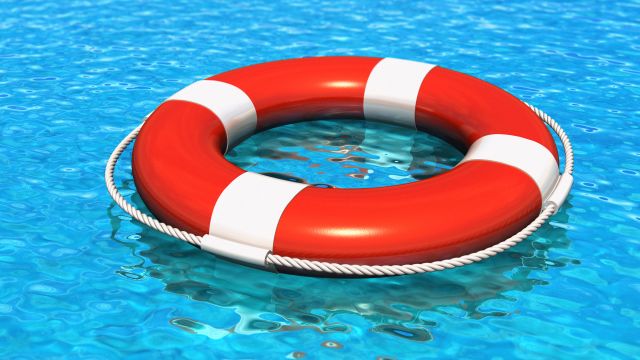If you’re the parent of a young child or a lover of water sports, the thought of drowning probably seems like a frightening, yet unlikely scenario. But many people don’t realize how common drowning actually is or the risk factors involved.
According to the Centers for Disease Control and Prevention (CDC), 4,000 Americans die from drowning each year. And when it comes to kids ages 1 to 4 years old, drowning was actually the leading cause of accidental death in 2016, says Dr. Tony Wanna, an Emergency Department physician at Presbyterian/St. Luke's Medical Center in Denver, Colorado. Wanna continues, “This correlates with the time children begin to walk. Any unguarded body of water is a major risk with new walkers nearby. This includes baby pools and bathtubs, with reports of children drowning in less than 6 inches of water.”
While toddlers and preschoolers are most at risk when it comes to swimming pools and other man-made bodies of water, drowning accidents involving teens and young adults often happen outdoors in lakes and rivers. Beyond age, gender and race can also play a role in drowning risk. According to the CDC, males make up 80 percent of drowning fatalities. And unfortunately, African-American children and teens have a much higher drowning risk, perhaps due to a lack of swimming skills.
Wanna backs up this statistic saying, “There are a lot of stereotypes out there about men and women, but men are involved in more accidents and traumatic incidents than women. Drowning is a leading cause of death worldwide among boys. They are four times more likely to drown compared to females their age.”
A cold beer before hopping into the lake might like a refreshing way to cool off, but it’s important to note that alcohol consumption also increases drowning risk. Wanna states that he’s seen this in his own practice. “It's estimated that anywhere from 20 to 50 percent of teenage and adult drownings are related to alcohol consumption,” he says.
What drowning actually looks like
Drowning might look different than you think. Movies and television often portray drowning victims flailing their arms wildly and calling for help, but accidents can happen rapidly and silently; especially when it comes to children.
According to research done by Dr. Francesco A. Pia, PhD and an article in the US Coast Guard’s Search and Rescue Journal On Scene, there is something called the Instinctive Drowning Response. Drowning can happen in under a minute and because the individual might be using all of their energy to keep their head above water, they may not be able to call for help. They typically appear vertical in the water, with arms at their sides. Some drowning victims may appear as though they are climbing an invisible ladder in an attempt to keep their head from submerging. Watch for subtle signs, such as hair covering a drowning individual’s eyes.
Wanna concurs saying, “Most patients will just go under and stay under due to inability to swim, intoxication, blacking out from hyperventilating before submersion or ascending too quickly after diving.”
You may have heard reports of “dry drowning,” “secondary drowning” or “near drowning,” in which a child dies days or a week after swimming, but according to the American College of Emergency Physicians, those terms are all discouraged. Dry drowning is not a real condition, as it is not possible for a drowning death to occurs days or weeks after the incident. A 2017 review on the topic stated, “There has never been a case published in the medical literature of a patient who received a clinical assessment, was initially without symptoms, and later deteriorated and died.”
However, if you suspect your child aspirated water or develops a cough, you should always bring them to the emergency room. Wanna says that it’s not uncommon for complications to arise shortly after an incident. He explains, “The earliest symptom of trouble is actually a cough. More worrisome signs such as abnormal breath sounds, difficulty breathing and finally confusion and loss of consciousness can follow the cough. If there is any question of whether a child is in danger, monitoring has to happen, either at home or the ER.” If these symptoms occur days later, they are likely unrelated, but seek medical attention regardless.
How to prevent accidental drowning
For parents of young children, drowning can be a scary prospect, but as long as you take precautions, you can still enjoy the water. Wanna says the best way to prevent drowning is education. “This not only involves the parents, but the community—grandparents, siblings, uncles, aunts and friends,” he notes.
If young children are present, never leave them unattended around any sources of water. This includes not only the bathtub, pool or open bodies of water but even filled buckets, toilets, garden ponds or large puddle and drainage ditches. “Children must be watched around water constantly,” Wanna warns. “I would not leave children less than 4 years old unattended in a bathtub for a second.”
There are a number of things you can do to decrease your drowning risk. Always provide vigilant supervision of children around any form of water—no texting or scrolling through social media. Consider fencing in any outdoor pools or entrances to water and securing them with gates outfitted with alarms or chimes when they open. Do not rely on air-filled or foam water toys as a measure of safety. Instead make sure children and family members have well-fitting life jackets, especially if they are going into open bodies of water. Use the buddy system when swimming and be aware of weather conditions, strong wave or rip currents. Adults should consider learning CPR, especially if they have a young child. Enroll your child in swim lessons, so they can learn water safety. People of all ages should wear a Coast Guard-approved life jacket while boating. Finally, opt out of swimming or boating while under the influence of alcohol or sedatives.






